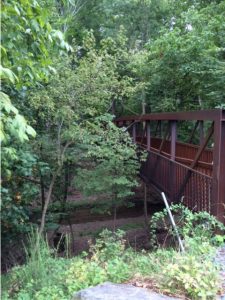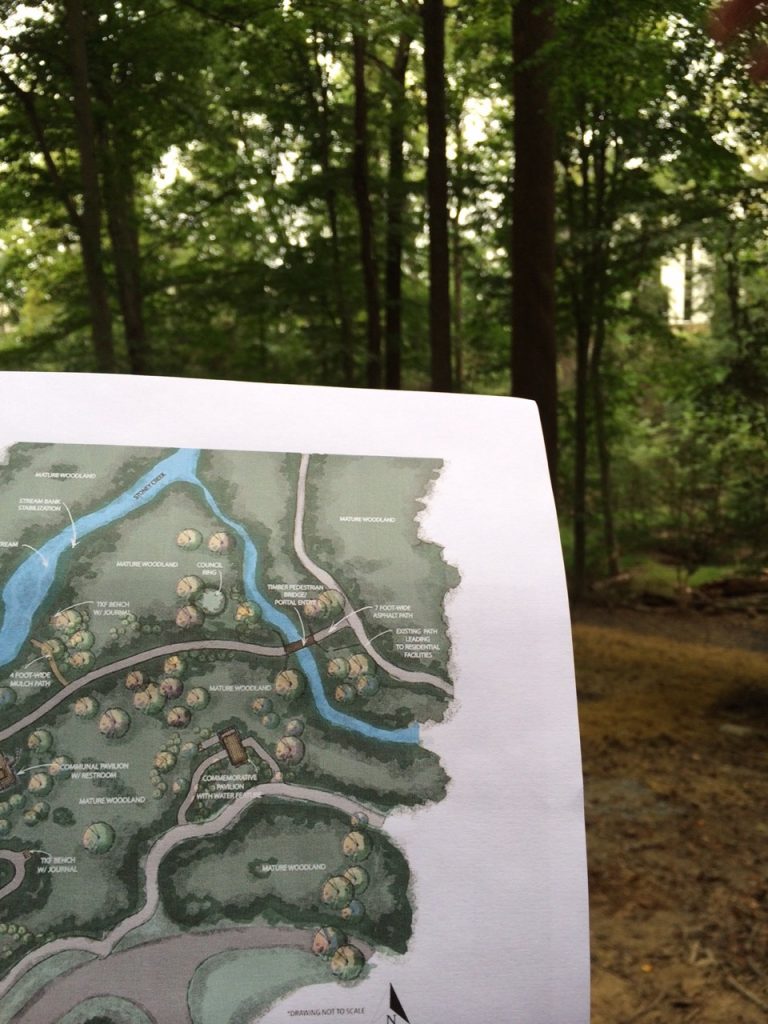Posts Tagged ‘wounded warriors’
The “Green Road”: Healing wounds of war with nature. Part 2
The first sign that I was getting close to the “Green Road” was a view of a grove of trees and a flock of geese staidly crossing the street nearby. The urban noises began to fade as sounds of crickets and birds gradually replaced them. It was like the “slow fades” between lands in a Disney theme park. Soon, I was surrounded by trees as I entered an entirely new world.  The gently sloping paved switchback path led to an old iron bridge across the Rock Creek. As I crossed the bridge over the pebbled lazy stream below, I could see deer grazing among the trees. The leaf-strewn path led to an open area where large granite rocks had been placed in a circle – inviting visitors to gather and share songs and stories. Farther on, beside the stream, was one of the signature large oak benches that the TKF Foundation places in all their gardens. There, visitors can contemplate in peace, or write their thoughts in a waterproof journal placed underneath the seat. Up on the steep hillside above the stream was a simple covered wooden structure, held by a low dry rock wall. A single large slatted wooden bench at its back, welcomed one to sit in quiet and remember loved ones lost in battle.
The gently sloping paved switchback path led to an old iron bridge across the Rock Creek. As I crossed the bridge over the pebbled lazy stream below, I could see deer grazing among the trees. The leaf-strewn path led to an open area where large granite rocks had been placed in a circle – inviting visitors to gather and share songs and stories. Farther on, beside the stream, was one of the signature large oak benches that the TKF Foundation places in all their gardens. There, visitors can contemplate in peace, or write their thoughts in a waterproof journal placed underneath the seat. Up on the steep hillside above the stream was a simple covered wooden structure, held by a low dry rock wall. A single large slatted wooden bench at its back, welcomed one to sit in quiet and remember loved ones lost in battle.
 The path led to a tiny wooden cabin whose roof shaded a wooden picnic bench with iron joints salvaged from the World War II battleship SS Diamond Head. A crowd of civilians and military personnel from the Army, Navy and Marines were gathered there, listening as the sweet voices of two women singing America the Beautiful filled the clearing. Photographers and TV camera crews stood behind the rows of people on folding chairs. After speeches and thank you’s from dignitaries, including Capt. Fred Foote, the Base Commander, Senator Barbara Mikulski, and the funding partners –The Institute on Integrative Health, and TKF’s Tom Stoner, the ribbon cutting officially opened the site (a green ribbon, of course!). We were then free to wander in the grove before retiring to the USO lounge for a barbeque lunch.
The path led to a tiny wooden cabin whose roof shaded a wooden picnic bench with iron joints salvaged from the World War II battleship SS Diamond Head. A crowd of civilians and military personnel from the Army, Navy and Marines were gathered there, listening as the sweet voices of two women singing America the Beautiful filled the clearing. Photographers and TV camera crews stood behind the rows of people on folding chairs. After speeches and thank you’s from dignitaries, including Capt. Fred Foote, the Base Commander, Senator Barbara Mikulski, and the funding partners –The Institute on Integrative Health, and TKF’s Tom Stoner, the ribbon cutting officially opened the site (a green ribbon, of course!). We were then free to wander in the grove before retiring to the USO lounge for a barbeque lunch.
I had wandered the grove myself on the Saturday before the event, picking pebbles by the stream, sitting on the benches listening to the forest sounds: the water swooshing over rocks, the wind in the trees, the birds’ cheeping, and the crunch of leaves underneath my feet.
It was indeed a healing place – a place of peace amidst the clatter and fray of the outside world; a place to heal the wounds of war.
The “Green Road”: Healing wounds of war with nature, Part 1
After the young service woman in full Navy camo cleared me for base access at the Visitor’s Entrance check-point, she pointed to the familiar white art deco tower of what used to be called the Bethesda Navy Hospital.“Just head up there, turn left and head straight to the USO. It’s a long walk,” she cautioned.
As I started my trek up the hill I felt anxious, not knowing exactly where I was going. But as soon as I saw a small printed sign by the edge of the road festooned with a green ribbon, I smiled. Finding my way to the site would be like a scavenger hunt!
I was at the Walter Reed National Military Medical Center military base in Bethesda, Maryland, for the opening of the “Green Road” Project. It had been 5 years in the making. The goals: to retrofit a branch of the Rock Creek that flows through the base, make it ADA accessible for wheelchairs and anyone with difficulty walking, and create a healing forest glen where wounded warriors and their families could gather and find respite while being treated at the many hospitals on base.
I had been involved in the project from the start, having advised the CEO and founder of the TKF Foundation and his Board on the most impactful way to dispose of the Foundation’s funds as they searched for a way to sunset it. Up until that time the Foundation had built hundreds of healing, sacred nature spaces throughout Maryland and the mid-Atlantic region. They wanted to use their remaining funds to build a smaller number of gardens that would have greater national impact. They had asked me, and a group of experts, to advise them on how to accomplish that.
I had been working with Capt. Fred Foote, a retired Navy doc, at the then Bethesda Naval Hospital. As he worked to bring holistic mind-body integrative treatments into the armamentarium of military medical care, he dreamed of creating a healing forest glen as a sanctuary for service personnel and their families. It was a no-brainer, I thought – put him together with TKF to do it. Building this nature sanctuary at the nation’s flagship medical center – the one where Presidents are treated – would be sure to have tremendous national impact.
As I picked my way along the base’s busy urban street, past the hospital’s main entrance, a continuous stream of trucks and cars passed by, leaving behind their smells of exhaust and diesel. Loud machinery noises filled the air – constant humming emanating from whole buildings filled with heating and air conditioning equipment for the base; jack-hammering and clangs of construction equipment. The sidewalk was sloped and there were many streets to cross. I couldn’t imagine how anyone in a wheel chair or on crutches could navigate this route without stress, twice daily to and from their living quarters to the hospital.
To be continued…

